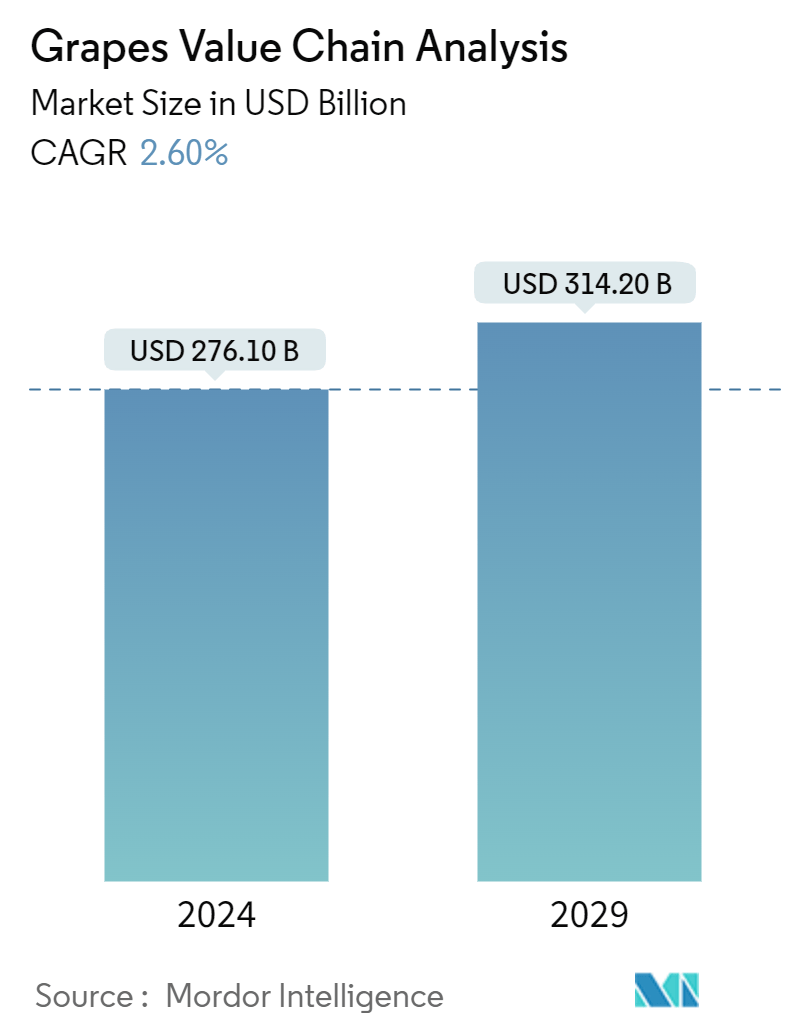| Study Period | 2019 - 2029 |
| Base Year For Estimation | 2023 |
| Market Size (2024) | USD 276.10 Billion |
| Market Size (2029) | USD 314.20 Billion |
| CAGR (2024 - 2029) | 2.60 % |
| Fastest Growing Market | Asia-Pacific |
| Largest Market | Asia-Pacific |
Grapes Value Chain Market Analysis
The Grapes Market size is estimated at USD 276.10 billion in 2024, and is expected to reach USD 314.20 billion by 2029, growing at a CAGR of 2.60% during the forecast period (2024-2029).
- Grapes rank among the world's largest fruit crops, cultivated over an estimated 6.7 million hectares globally. The United States Department of Agriculture’s Foreign Agricultural Service projects the global production of fresh table grapes for the 2023/24 season to reach 28.1 million metric tons. This optimistic projection is supported by favorable growing conditions in India and China, offsetting weather-related challenges faced by the European Union, Turkey, and the United States. Globally, the two predominant types of grapes cultivated are table grapes and wine grapes, with table grapes being primarily intended for fresh consumption.
- Farmers are the key players in the grape value chain, directly engaged in grape production. This group encompasses individual farmers and entrepreneurs who not only cultivate grapes using diverse farming techniques but also partake in processing activities, including post-harvest handling, marketing, and distribution. Numerous farmers' associations exist across various grape-producing nations. Notably, the International Viticulture and Enology Society (IVES) and the International Organization of Vine and Wine are instrumental in the grape supply chain.
- Importers and exporters are pivotal to the global grape value chain. Leading the charge in exports are countries from Latin America and Europe, with Chile, Peru, Italy, and the Netherlands at the forefront. Additionally, Asian and African nations, especially China, India, and South Africa, make notable contributions. These nations boast a robust network of export traders, essential to the value chain, who source grapes directly from local farmers or organizations. Key importing nations encompass the United States, Germany, Canada, and the United Kingdom, among others.
- Key players in the global grapes market include wholesalers such as Exim Trading Global, Beva Fruits International (BFI), and More Than Grapes. These wholesalers leverage global sourcing and logistics networks to distribute grapes in high-demand markets, all while ensuring compliance with USDA and EU organic standards. Major retailers, including retail giants like Carrefour, Walmart, and Tesco, are among the primary buyers of these grapes.
Grapes Value Chain Analysis Industry Segmentation
A grape is a fruit, botanically a berry, of the deciduous woody vines of the flowering plant genus Vitis. Grapes are a non-climacteric type of fruit, generally occurring in clusters.
The Grapes Value Chain Analysis Market Report offers an Overview, Price Markups, Stakeholders, and Issues and Challenges of the value chain and supply chain of Grapes.
Grapes Value Chain Analysis Size Summary
The grape industry is a significant segment of the global agricultural market, with grapes being one of the largest fruit crops cultivated worldwide. The value chain of grapes involves multiple stakeholders, starting from farmers who bear the initial costs of production, including seeds, labor, and transportation. Following farmers, aggregators or farmer cooperatives play a crucial role in the supply chain, which is then followed by exporters from major producing countries like the United States, Peru, Chile, and the Netherlands. These exporters incur additional costs such as labor, transportation, and packaging. The chain continues with importers and wholesalers, culminating with retailers who also bear costs related to transportation and packaging. The development of new grape varieties through research and development activities is essential for meeting the increasing consumer demand, driven by the health benefits associated with grape consumption.
The market for grapes is poised for substantial growth, fueled by rising health consciousness and the increasing popularity of grapes as a nutritious food option. Countries like China, Turkey, Brazil, and the United States are leading producers, with China being the largest globally. The expansion of the wine industry, particularly in China, further boosts grape production, as grapes are the primary ingredient in wine manufacturing. Investments in production facilities and the adoption of new cultivation techniques are contributing to increased grape yields. The market is also witnessing technological advancements, such as the integration of blockchain for traceability in exports, which enhances the efficiency and security of the grape value chain. As consumer awareness and demand continue to rise, the grape market is expected to experience robust growth during the forecast period.
Grapes Value Chain Analysis Size - Table of Contents
Grapes Value Chain Analysis Market Research FAQs
How big is the Grapes Market?
The Grapes Market size is expected to reach USD 283.28 billion in 2025 and grow at a CAGR of 2.60% to reach USD 322.07 billion by 2030.
What is the current Grapes Market size?
In 2025, the Grapes Market size is expected to reach USD 283.28 billion.



